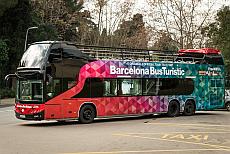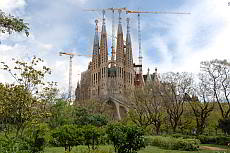Monestir de Pedralbes - Monastery of Pedralbes
One of the most beautiful monasteries of Catalan Gothic
The Monastery of Pedralbes or Monestir de Pedralbes is certainly one of the most beautiful gothic buildings in Barcelona.
Content of this page
The complex, built in the early 14th century, shows the everyday life of the nuns, while the Pedralbes Monastery Museum exhibits sacred art from the 14th to the 20th century.
The three-storey cloister and the gardens inside the monastery are particularly beautiful.
The construction of Monestir de Pedralbes
The monastery was founded by Queen Elisenda de Montcada. She was supported by her husband, King James II (Jaume II), who had the monastery dedicated to Saint Mary. Therefore it is officially called "Reial Monestir de Santa Maria de Pedralbes". Since it was founded, the convent has been run by nuns from the Clarisse sisterhood.
Useful things to visit
The construction of the monastic buildings began in March 1326. The site within the village of Sarrià, then far outside the city walls of Barcelona, was chosen by Queen Elisenda. A white stone serves as the foundation stone for the apse. The name "Pedralbes" derives from the Latin Petras Albas (white stones). On May 3, 1327, the nuns moved into the convent.
The result of the short construction period of just one year is a particularly unified and harmonious example of Gothic architecture in Catalonia. At that time, the construction of a larger church or monastery was a project spanning several centuries, which is why several architectural styles can usually be recognized in one object, such as the cathedral. No other architectural styles influenced the construction of the Pedralbes Monastery.
In the 15th century the third and lowest floor of the cloister was added.
Visit of the Monastery of Pedralbes today
On the eastern side is the single-nave church. In this you will find on the right side next to a presbytery, a choir room reserved for the clergy, the tomb of Queen Elisenda, which has a special feature: the sarcophagus is divided in two in a curious way. The part facing the cloister shows the queen as a grieving widow, the part lying in the church shows Elisenda as queen.
Monastery of Pedralbes
There is no direct access to the interior of the monastery from the church. The entrance is a few meters from the church. From there you enter the cloister. It certainly makes sense to choose the tour that leads through the monastery complex in an anti-clockwise direction.
The first attraction is the small chapel of Sant Miquel on the right towards the church wall. Here the painter tells in his 1343 created frescoes from the life of Jesus and Maria. The special feature is the plastic representation, with which he emulated the Italian painter Giotto, who marked the beginning of modern painting.
In the next room of the cloister is the tomb of Queen Elisenda, described above. Further graves of superiors of the monastery follow on this side.
Several utility rooms and cells follow on the northern side of the cloister, as well as the staircase to the second floor, half of which is accessible. The third floor is not accessible.
Here you will also find the museum in the former dormitory of the monastery. It shows sacred art and everyday objects of the monastery from 14.-20. Century. In the central cloister you will also find a number of tiny prayer cells.
Going down the museum stairs again, you can continue the tour around the monastery in the lower cloister. On the western side are the utility rooms, such as the dining room, the kitchen and, in the basement, the storerooms of the monastery of Pedralbes.
In the basement is a very remarkable diorama display that tells the life story of Jesus.
The garden of Monestir de Pedralbes
The monastery would certainly not be half as beautiful and impressive if it weren't for the courtyard garden. Here you will experience a tranquility that you won't find anywhere else in Barcelona. You hear nothing here except for the chirping of birds and the splashing of the Renaissance fountain in the middle.
Large palm trees and cypresses provide pleasant shade. You have multiple access to the garden from the lower cloister.
Sisterhood of the Poor Clares
Francis of Assisi received Clare of Assisi, a nun of noble birth, into his Franciscan community in 1212. The sister community of the Clarisse nuns came into being, later also called the "Second Order" of the Franciscans.
The convent is still run by the Clarisse nuns, but they live in a more modern outbuilding.
Why the visit is worthwhile
Pedralbes Monastery is just outside the city center but easily accessible by hop-on hop-off bus. It is not as spectacular as, for example, the Sagrada Familia, Casa Milà or the Cathedral, but the monastery is very beautiful and has a lovingly tended garden. Especially in summer it is nice and cool here and you can enjoy a peace and quiet that is rarely found in Barcelona.
Book useful things for the Monastery of Pedralbes
(Click on the product images to view prices and availability)
- Bus Turístic: the station is 100 metres away from the cloister
- Barcelona Card: free admission to the Monastir de Pedralbes
Important information
Surroundings
Find Hotels nearby
Address
Baixada del Monestir, 9
Phone: +34 932 563 434
Arrival
Metro: Reina Elisenda (FGC L6)
Bus Turístic: Monestir de Pedralbes
Parking nearby
Opening times
Tue.-Fri.: 10.00 - 17.00
Sat: 10.00 - 19.00
Sun: 10.00 - 20.00
On public holidays 10.00 - 14:00
Closed on Mondays
Closed on: 1 Jan., Good Friday, 1 May, 24 June, 25 Dec.
Admission
Regular: €5.00, reduced: €3.50
Children until 15 years (an adult companion required): free admission
Disabled persons: €3.50
Free admission: 12 February (Santa Eulàlia), 18 May (International museum day), 24 September (Mare de Déu de la Mercè), 1st Sunday of a month, Sundys after 15.00
Tips for the visit of the Monastery of Pedralbes
If you are in Barcelona in summer, you can visit the Monastery of Pedralbes during the midday heat. In the church, the monastery and the garden it is pleasantly cool. For visiting you should plan about an hour.
You have free admission with the Barcelona Card and you can get directly to the monastery with the Bus Turístic.
Book your accommodation in Barcelona here! All categories.
1-5*-hotel rooms, apartments, hostels.






